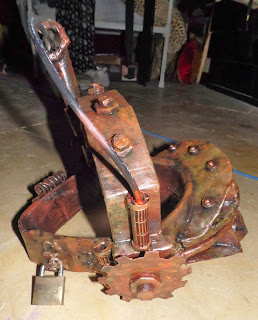Once all the glue has dried, the prop should be ready to paint. I recommend a few coats of black spray paint. I found this easier than trying to work a brush into all the nooks and crannies of the reverse bear trap.
Try to use a few thin coats rather than one thick coat. You want this to dry matte: I used too many thick coats and got shiny patchrd, though this didn't affect the final finish too much.
The next step was creating a rust texture. I used a very light coat of brown spray paint to start. You want a mottled appearance, so just apply a few puffs of the spray paint.
Next, time to dry brush. Dry brushing means using a dry paint brush and a tiny amount of paint, and applying that paint in a thin coat on your surface. THis allows the black surface to show from underneath, helping you achieve a rusty look. I used copper, silver, orange, raw umber, and yellow ochre acrylic paint to get a rusty colour.
You can also use acrylic paint as a kind of filler. If you have any gaps in the paper mache, use a little acrylic to fill the gap, then paint over it when it dries.
Here's the finished trap. I think it looks pretty good, and definitely more realistic than I thought it would.
Some details to remember: you need to add a little clock face to the back, to act as the timer.
And don't forget your padlock. Use a smaller one: it will be lighter, and less likely to rip the cardboard.










No comments:
Post a Comment